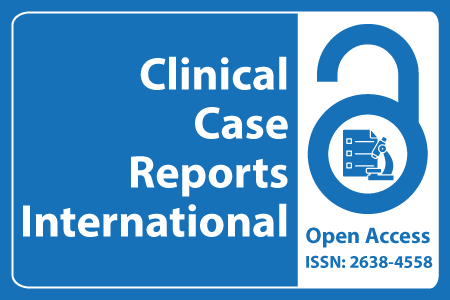
Journal Basic Info
- Impact Factor: 0.285**
- H-Index: 6
- ISSN: 2638-4558
- DOI: 10.25107/2638-4558
Major Scope
- Pharmacology and Therapeutics
- Endocrinology
- Pathology
- Nutrition and Dietetics
- Respiratory Medicine
- Pneumonia
- Allergy & Immunology
- Preventive Medicine
Abstract
Citation: Clin Case Rep Int. 2023;7(1):1617.DOI: 10.25107/2638-4558.1617
A Cystic Scare Case Report: A Rare Case of Hydatid Disease on a 41-Year-Old Male
Lacsina MAG, Tabora MC and Comia CT
Mary Mediatrix Medical Center, Philippines
Department of Cardiology, Mary Mediatrix Medical Center, Philippines
Department of Infectious Disease, Mary Mediatrix Medical Center, Philippines
*Correspondance to: Mary Abigail G Lacsina
PDF Full Text Case Report | Open Access
Abstract:
Echinococcosis or hydatidosis or hydatid disease is the most frequent cause of liver cysts in the world. The prevalence of hydatid cyst in humans appears to be directly related to a low level of sanitation. The disease is prominent in rural areas with poor housing conditions, where humans, dogs and cattle exist in close proximity. This paper presents a case of a 41-year-old, Filipino, male, no known co morbidities, business man and with history of previous travels abroad who presented with fever and watery, non-bloody, non-mucoid stool. No other associated symptoms such as cough, colds, abdominal pain, chest pain and dysuria. Upon consult, patient was initially managed as a case of Infectious Diarrhea. Imaging techniques are essential for diagnosis, with the relatively inexpensive and portable Ultrasound (US) widely used to diagnose CE or AE liver lesions; X-ray is used for lung cysts in which were also done to the patient. Medical therapy of hydatidosis has been tried with many drugs including benzimidazole carbamate group. Mebendazole was the first drug to be used for hydatid disease. Albendazole given preoperatively in dose of 10 mg/kg/day for 1 month causes sterilization of the hepatic hydatid cyst, killing most of the protoscolices. Surgical procedure was not indicated for the patient since the size of the cysts were to small and medical treatment was more beneficial for the patient.
Keywords:
#
Cite the Article:
Lacsina MAG, Tabora MC, Comia CT. A Cystic Scare Case Report: A Rare Case of Hydatid Disease on a 41-Year-Old Male. Clin Case Rep Int. 2023; 7: 1617.













